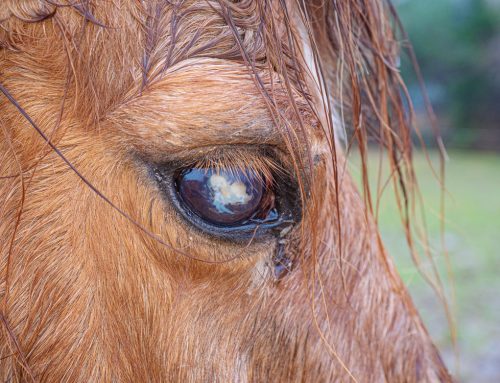Navicular syndrome is a chronic, progressive condition that causes pain in the heel region and subsequent lameness in horses. Our Leatherstocking Veterinary Services team knows that a navicular syndrome diagnosis is upsetting for horse owners, and we explain the condition and management strategies.
Equine navicular apparatus anatomy
To understand navicular syndrome, you first must understand the navicular apparatus, which is composed of five structures:
- Navicular bone — A small, flattened bone that lies across the back of the horse’s coffin joint
- Deep digital flexor tendon (DDFT) — The continuation of the deep digital flexor muscle that runs down the back of the horse’s leg, over the navicular bone, and attaches to the coffin bone
- Navicular bursa — A small, fluid-filled structure that acts as a cushion between the navicular bone and the DDFT
- Collateral sesamoidean ligament (CSL) — The ligament that attaches to the navicular bone to the short pastern bone
- Collateral sesamoidean impar ligament (CSIL) — Attaches the navicular bone to the coffin bone
Navicular syndrome can involve abnormalities in one or more of these structures.
Equine navicular syndrome causes
The underlying cause of navicular syndrome is not fully understood, but several factors, including genetics, environmental conditions, and biomechanical forces, likely contribute to the issue. Navicular syndrome is especially common in certain breeds, including quarter horses, thoroughbreds, and warmbloods, which suggests a genetic component. Environmental factors may include poor hoof care or inadequate exercise, while poor conformation, excessive front limb weight bearing, and inappropriate shoeing practices may also contribute.
Equine navicular syndrome signs
Equine navicular syndrome typically manifests as front limb lameness, but often involves both front feet, which can make detection difficult. Potential signs include:
- A head bob at the trot
- Choppy front end gait
- Exaggerated head bob on a tight circle
- Reluctance to work or increase speed above a walk
- Hoof pointing when standing
- Increased lameness when a hoof grows too long
The condition typically starts in horses in middle-age and chronically progresses through the horse’s life.

Equine navicular diagnosis
Potential diagnostic tests include:
- Physical examination — We perform a thorough physical examination, assessing your horse from nose to tail. We evaluate their limbs for injuries, swellings, and any abnormalities that would cause discomfort.
- Lameness examination — We carry out an in-depth lameness evaluation that includes:
- Hoof testing — We use hoof testers to squeeze your horse’s hoof in different areas to assess for pain. Many horses affected by navicular syndrome exhibit pain when their heel is squeezed.
- Straight line assessment — We watch your horse walk and trot in a straight line.
- Assessment on a circle — We watch your horse walk and trot in a circle to the left and right. Most horses with navicular syndrome exhibit a more pronounced head bob when the painful hoof is on the inside of the circle.
- Flexion testing — We flex each joint to determine if stress increases your horse’s lameness. Flexing the lower limb often causes horses with navicular syndrome to exhibit a more exaggerated lameness.
- Nerve blocks — Nerve blocks involve injecting a numbing solution to help localize the painful area. If both feet are affected, blocking one foot may make your horse become noticeably more lame on the other foot.
- Blood work — In some cases, we may perform blood work to rule out other conditions and assess your horse’s overall health.
- X-rays — X-rays can identify changes to the navicular bone.
- Advanced imaging — Since the hoof wall prevents viewing the area’s soft tissue structures in this area by other imaging techniques, magnetic resonance imaging (MRI) is sometimes needed to fully understand what structures are affected.
Equine navicular syndrome treatment
When developing a treatment plan, we consider the severity of your horse’s signs, and their intended use and workload. Potential treatment strategies include:
- Rest — Continued strain on the navicular region exacerbates the problem. Rest is necessary for healing, but strict confinement is contraindicated. Pasture or paddock turnout is best.
- Corrective hoof balance and shoeing — Horses with navicular syndrome often have unbalanced hooves, including long toes and low, underrun, and contracted heels. Goals of corrective hoof balance and shoeing include correcting the hoof pastern axis, maintaining heel mass to protect the navicular area from concussion, and shortening the toe to allow an easier breakover. X-rays are helpful to determine if a horse needs more or less heel elevation and if their toe is shortened sufficiently. Radical changes in the foot can increase lameness, and hoof balance often must be corrected in stages.
- Joint injection — Anti-inflammatory medications can be injected into the navicular bursa and the associated joint to address navicular area pain.
- Systemic anti-inflammatories — Non-steroidal anti-inflammatories (NSAIDs) are commonly used to treat horses with navicular syndrome.
- Vasodilators — Some vasodilator drugs have been successfully used to relieve clinical signs.
- Bone metabolism medications — These medications work to normalize bone metabolism by inhibiting bone resorption.
- Surgery — In severe cases, a surgery called a neurectomy can prevent the horse from feeling the painful navicular area. However, this procedure does not prevent disease progression, and serious complications can result, since the horse can no longer feel the back part of their foot.
If your horse is lame, contact our Leatherstocking Veterinary Services team, so we can determine if they have navicular syndrome and devise an appropriate treatment protocol and make them as comfortable and as active as possible.







Leave A Comment